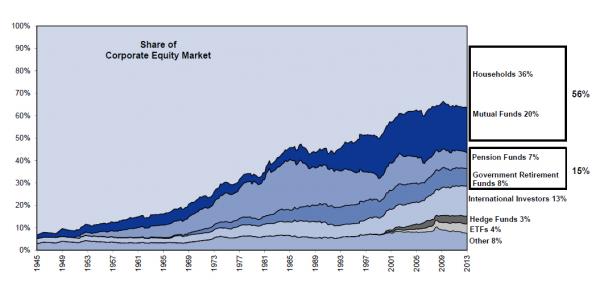When it comes to the conventional wisdom of who owns the bulk of corporate stock in the US equity market, the consensus is simple: at 36% of total, the answer is the US household. This is shown in the chart below.

As an aside we disagree from this simplistic analysis because as is well known, the “Household” category, which is pulled from the Fed’s quarterly Flow of Funds report, is merely a placeholder plug, designed to balance out all the other member categories. What is less known is that entities such as hedge funds use extensive “off the books” leverage (just ask Citadel and its nearly 9x regulatory leverage) to hold far more equities than their capital allows them. Which means that in reality the US household owns far less stock than is believed.
But even if one takes the Fed’s data at face value, what becomes clear is that having owned virtually the entire stock market in 1945, households are now down to nearly their lowest fractional ownership in history, with the rest alloted to mutual, pension and retirement funds.
And it is only going to get worse.
According to a recent analysis by Goldman, in 2014 the US household is on track to withdraw a whopping $430 billion from US corporate stocks. i.e., sell. This will be the biggest net outflow by the Household group, which has constantly withdrawn cash from equities over the past decade, since the last market peak.

It is understandable why: with baby boomers retiring in droves, and with interest income non-existent, investors are forced to liquidate positions in order to generate, well, liquidity.
Perhaps a more disturbing question is why is the household outflow not bigger? After all it surpassed $1 trillion during the last market peak. Could it be because households just don’t have all that much equity left in a market which is now dominated by a mere tiny fraction of the entire US population?
But the biggest question is with household pulling cash out, who will provide the offsetting inflow into stocks? The answer: corporations of course – the same entity that injected a record $500 billion in stocks in the form of buybacks is set for another bumper year of net inflows, and according to Goldman companies are on par to match their 2013 buyback activity by buying back some $450 billion of their own stock in the coming year.

